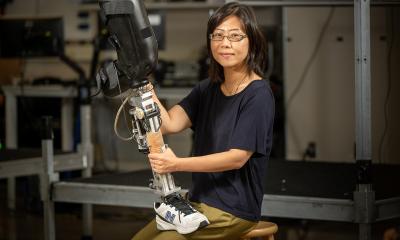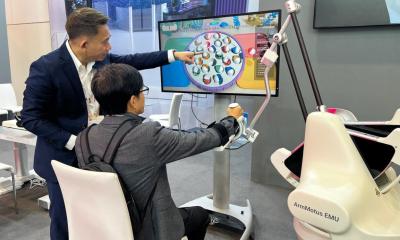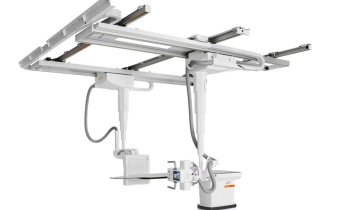Muscle signals
Robotic glove restores hand movements
Patients who have lost their hand functions due to injuries or nerve-related conditions, such as stroke and muscular dystrophy, now have a chance of restoring their hand movements by using a new lightweight and smart rehabilitation device called EsoGlove developed by a research team from the National University of Singapore (NUS).

Made of soft materials, this novel device is an improvement from conventional robotic hand rehabilitation devices as it has sensors to detect muscle signals and conforms to the natural movements of the human hand, reducing discomfort and risk of injury. This robotic glove is also compact and portable, so patients who are recovering at home or are bedridden could carry out rehabilitation exercises with greater ease and comfort.
Assistant Professor Raye Yeow from the NUS Department of Biomedical Engineering, who specialises in soft wearable robotics and is a key member of the research team, explained, “For patients to restore their hand functions, they need to go through rehabilitation programmes that involve repetitive tasks such as gripping and releasing objects. These exercises are often labour intensive and are confined to clinical settings. EsoGlove is designed to enable patients to carry out rehabilitation exercises in various settings – in the hospital wards, rehabilitation centres and even at home. Equipped with technology that can detect and interpret muscle signals, EsoGlove can also assist patients in daily activities, for instance by guiding the fingers to perform tasks such as holding a cup.”
The NUS team comprises Asst Prof Yeow, his clinical collaborator Dr Lim Jeong Hoon from the NUS Department of Medicine, as well as PhD candidate Mr Yap Hong Kai and undergraduate student Mr Benjamin Ang Wee Keong, who are both from the NUS Department of Biomedical Engineering.
Greater comfort and convenience
Conventional robotic devices for hand rehabilitation consist of rigid electromechanical components, which are heavy and uncomfortable for patients.“EsoGlove is unique as it is made entirely of soft components and does not require complicated mechanical setups. The main body of the glove is made of fabric, with soft actuators embedded. It also has adjustable Velcro straps to cater to different hand sizes,” Asst Prof Yeow said.
EsoGlove is connected to a pump-valve control system that modulates the air pressure which directs the soft actuators. When the actuators are pressurised by air, they apply distributed forces along the length of the finger to promote finger movements, such as bending, extending and twisting, to support different hand motions. This novel method does not constrain the finger’s natural movements, unlike conventional devices that make use of rigid links and joints. Each actuator also functions independently, providing assistance to each finger separately. The robotic glove can be applied in a table-top version for bedridden patients, as well as a waist-belt version for patients who are mobile and recovering at home.
Smart control and assistance
EsoGlove uses an intuitive control mechanism that involves the coupling of electromyography and radio-frequency identification technologies. With this feature, the robotic glove can detect a patient’s intent to perform a hand action on a particular object, such as picking up a pen or holding a mug. By interpreting the muscle signals of the wearer, the robotic glove can help the patient move the fingers to accomplish the specific tasks, involving objects of various shapes and sizes, in an intuitive manner.
Said Dr Lim, who is also a Senior Consultant at the National University Hospital’s Division of Neurology, “With this unique approach, we can develop therapeutic tools using safe and wearable robotic technology. Patients can take the initiative in their own rehabilitative process, rather than being passive recipients of therapists’ intervention.”
“As the soft actuators in the EsoGlove are made from non-ferromagnetic materials, they are suitable for use in functional magnetic resonance imaging studies. We hope that the robotic glove can contribute towards investigating the brain’s activity in relation to motor performance during hand rehabilitation, and unravel the functional effects of soft rehabilitation robotics on brain stimulation,” added Mr Yap, who is also from the NUS Graduate School for Integrative Sciences and Engineering.
Clinical studies and commercialisation
Asst Prof Yeow and his team plan to start pilot clinical studies at the National University Hospital in February 2016 to validate the device’s performance, as well as to obtain patient and clinical feedback so as to further refine the design of the device. The studies will take about six months, involving 30 patients.
Source: National University of Singapore
22.01.2016











